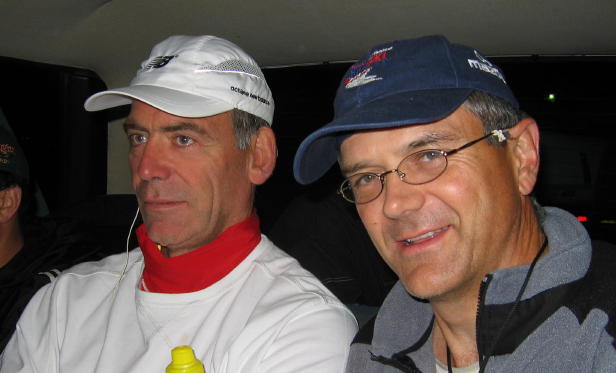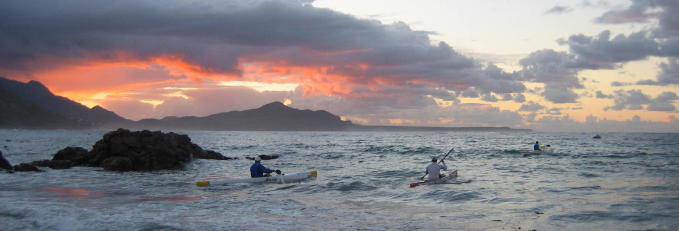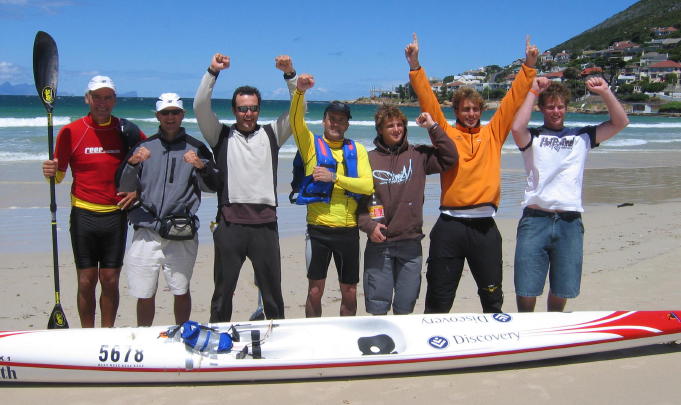Cape Point Challenge Practise Run 2005
 A group of paddlers has been training for the Cape Point Challenge under the tutelage of Dawid Mocke. Last Friday he took us out onto the course to do the full 56km… Here’s the story.
A group of paddlers has been training for the Cape Point Challenge under the tutelage of Dawid Mocke. Last Friday he took us out onto the course to do the full 56km… Here’s the story.
On Thursday evening the group of intrepid paddlers met at Fish Hoek to put the surf skis onto the trailer that was going to be used the next day. Everyone was a little tense, including coach Dawid who seemed very focussed – perhaps he was feeling the responsibility for taking a bunch of novices through the Point… Then it was home to have supper. I’d previously mentioned to my wife apropos of nothing at all that Dawid had said that he always eats steak the night before a big race… The hint struck gold & a hearty steak washed down with a good Cape red made the ideal preparatory meal.
Early Start
On Friday I got up at about 03h35, later than I had intended, and ran around in a daze making porridge and trying to remember what I needed to do and why. Eventually I stumbled out to the car, having crept in to put the alarm clock back next to the beloved (I’d slept at the other end of the house!).
I picked up my paddling buddy Damian at his house at 04h05 and then we were on our way to the rendezvous, driving in the cold and dark. As we drove through some rain squalls we wondered for the nth time whether this really was a good idea. But, by the time we got to Fish Hoek, the rain had stopped. We arrived five minutes early; all was quiet. The sea was crashing onto the shore with an ominous roar; the forecast said that the wave size was supposed to drop through the day but we’d just had several days of strong winds and it seemed that the swell was still quite big.
Safety Prep
But that was all forgotten as the rest of the vehicles started to arrive; a pickup with the escort boat – a large twin-engined rubber duck – and the VW kombi that was to tow the trailer with all the skis. Having manhandled the trailer onto the back of the kombi we all re-checked our equipment and bundled ourselves into the kombi – only to wait while the escort boat’s engines were also checked and “dry-started”.

Finally we got going and as we drove through the night, the stories were flying back & forth and jokes were being told. By the time we got to Soetwater, the starting point, the eastern sky was lighting up and we could see that the waves weren’t too big and that the wind was hardly blowing at all. In fact, conditions looked ideal for the paddle. We’d arranged that the slower paddlers, would start first, 15 minutes ahead of the next group. One of the stronger and more experienced paddlers (who’d done the race twice before), volunteered to accompany them.
Godfrey Mocke, Dawid’s dad, gathered us around for a pre-trip prayer. Godfrey is a wonderful character, full of inspiration and encouragement. His email the day before, full of detailed information about the arrangements had had a distinct calming effect and boosted on my confidence.
Godfrey Mocke's Speedo
We all helped manhandle the escort boat into the water and the three occupants, the driver, a press photographer (briefed to take shots as we went around the point) and Godfrey got in. In the cold dawn, Godfrey amazed us with his foul weather gear; he was wearing a pair of takkies and a speedo! That was it. We were jumping around in our paddling gear trying to get warm in the pre-dawn cold and there was Godfrey preparing to spend seven hours on the boat – in a speedo!

Setting off
Shortly afterwards the first three paddlers set off; just as the sun was rising and the first rays were stabbing through the clouds over the mountains.
The rest of us bustled around disappearing behind the sand dunes at intervals(!) and making last minute adjustments to leashes; to lifejackets and to drinking systems. Fifteen minutes later it was the turn of the second group to leave.
As usual I felt cold and unstable during the first ten or so kilometres. I always take some time to get going and the thought of the notorious “South Western Reefs” filled my mind with something approaching dread. It was also becoming apparent that the swells were still huge after the previous days’ storms. The seas were confused, as expected; all along that section of the coast, the big ocean swells roll in from the South Atlantic, hit the shore along the peninsula and bounce off, the reflected waves causing a tricky confused chop that threatens to spill unwary paddlers off their skis.
Nervous
Two other things were making me nervous; the fact that paddling buddy Damian was on a borrowed ski and was feeling unstable and uncomfortable - and the thought of bluebottles. I’d been stung badly the previous weekend by some of the beastly little critters and when we started to spot more and more them I was not pleased! I’d bought some “Stingos” gel and had it with me in my lifejacket pocket. But I was not keen to test it for the first time at the beginning of a 56km paddle! Happily after the first hour we saw no more bluebottles.
Slowly the first landmark, Olifantsbos, came closer and the wreck of the WWII steamer, the “Tommy Tucker” became visible. As we got closer I reminded the others to take a drink – it’s easy to forget and dehydration is not a recommended state to get oneself into. Big Mac promptly took a swim as he reached for his drinking pipe. He climbed back on and we set off again.
Olifantsbos to Platboom
I had loaded our route into my GPS and as we passed Olifants, the indicator switched to the next waypoint, half way to Platboom, the next landmark. We seemed to be making slow progress; we had a slight headwind but the main factor was the chop, which made it difficult to settle into a good steady rhythm. I found myself bracing almost often as the awkward waves kept hitting me from all directions.
We caught up with the next group half way to Platboom. They too were having difficulties with the confused seas and I saw that one of the guys had fallen off (also trying to get to his drink) and was having problems getting in and staying in his ski. I paddled across and held the nose of his ski as he got in; that was all he needed and soon we were all on our way again. Alas, some fifteen minutes later, Mac fell off again. This time he took quite a while to get going again and eventually he told Damian and I to carry on without him; he’d stay with the next group.
As we paddled off we hit some of the massive kelp beds that are prominent along this coastline. We cut inside a kelp bed, but could see some huge breakers beyond. The waves all around us were suddenly assuming the “peaking” shape that generally indicates an imminent break. We definitely didn’t want to be around if they did start breaking so we turned sharply out to sea. One of the features of the dreaded South Western Reefs is that breakers can form essentially anywhere up to 2km out to sea. And they might form only once in five or ten minutes – so it’s no wonder that this section is described as treacherous by those who have been here. (The chart shows a large shaded area here with the encouraging words, “continuously breaks”.)
Cape Maclear to the Point
I didn’t enjoy this section at all. At least we were reasonably safe; we’d gone a long way out to sea to go around the reefs. But the next blow to our morale was the sight of another headland that appeared from behind what we thought was Cape Point. We’d been warned repeatedly that Cape Maclear (just before Cape Point) can be deceptive. There’s still quite a way to go after Cape Maclear to the point itself, we’d been told. Anyway – there was the new headland, and it was MILES away. Our hearts sank. We’d been paddling nearly three hours already and the headline was far, far away. Then Damian looked again at his GPS. 3km to go, it said. Hmmm… that headland was actually on the other side of False Bay, nearly 40km away! We WERE at the point and our morale was suddenly sky high!
The area through which we were paddling was totally confused and we had to work hard to stay on the skis, let alone make any progress. The Point seemed crawl invisibly closer – but all at once we were about 200m away from Point itself and we took a moment to look up at the lighthouse and the tiny lookout point far, far up above us. The cliffs were lit by the early morning sun and the air was crisp and clear – what a stunningly beautiful sight!
It had taken us nearly 3h30 to get there, but we were almost exactly half way.
Around the Corner - Cape Point to Buffels Bay
And as soon as we were around the Point and into False Bay itself the seas became benign and we were able to catch some small runs as we scampered down the coast the 6km to Buffels Bay. During the race there’s a compulsory 10 minute stop at Buffels and we were to stop there now as well to simulate the conditions on race day. As we got closer we saw the two vehicles, people on the beach and Dawid and his brother’s skis. They’d passed us somewhere on the other side and, having started fifteen minutes after us, had reached Buffels some twenty minutes before us! Humbling stuff!
As we stumbled onto the beach, we were met by Dawid’s mom and Big Mac’s family. Hot coffee, Chelsea buns and cold pasta were on offer. It’s vital to eat at this point in the paddle as your body has burnt up a huge amount of energy. If you don’t eat, you hit the wall on the home stretch. So I forced a couple of buns down, a few mouthfuls of pasta and had a cup of coffee. I added an energy bar to the mix, washed down with some of my Fast Fuel energy drink… We were getting cold fast. We actually spent too long on the beach (nearly twenty minutes) but at last Damian and I set off again. As we did so Mac and Ian hove into view on their way in, the rest having arrived a few minutes before.
Buffels to Smitswinkel Bay - unexpectedly rough
The next section was unexpectedly difficult. We ought to have angled further out into the bay in order to pick up the swells and the developing southeaster that was beginning to blow (just in time to help us back to Fish Hoek!). But we didn’t and instead found ourselves in almost the most turbulent seas yet. Between Buffels and the next landmark, Smitswinkel Bay, there’s a section of coastline that comprises sheer cliffs that fall straight into the sea. The swells hit the cliffs head on and rebound with almost all their energy intact and the resulting washing machine effect is incredibly difficult to paddle through. I fell off, not once, but twice. By the time I was back on the second time, Damian had gained several hundred metres and was disappearing over the horizon.
But as we got to Smits, the difficulties melted away and the home stretch became a simple and increasingly enjoyable downwind run. In retrospect we should have angled further out, sooner from Buffels to get out of the tricky water and into the swells and wind.
Home Run
The run from Smits to Fish Hoek went past Partridge Point where we sped past the rocks over which the swells were breaking impressively; past Bakoven Rock which marks the start of our regular downwind run from Millers Point; on to the lighthouse at Roman Rock and finally into Fish Hoek bay.
Damian had vanished at Partridge Point; he got into Fish Hoek some nine minutes or so ahead of me. I landed at 12h10 having spent almost exactly six hours on the water.
We all made it, our times varying between about 5h30 and over 7 hours – a huge effort.
Do we really need to do this again?
I have to say that at the time my thoughts were running along the lines of: “Paddling past Cape Point has been one of my life goals. A check box item you might say. But you only need one tick in a checkbox… is there really any necessity to do this again on 17th December?” But bad memories fade fast and the glow of achievement remains longer; I’ll be back on the 17th – I think. Of course should the southeaster be howling and a massive Atlantic swell be crashing onto the South Western Reefs, I retain the right to say “stuff it” on the day!

Damian, Mac and I had lunch together afterwards; omelettes accompanied by beer. Sounds horrible but it worked! The beer was exactly what I needed. Then it was home, where I collapsed into bed and slept for three hours…
An awesome day.
More info on the race can be found on www.surfski.co.za in the events section.

